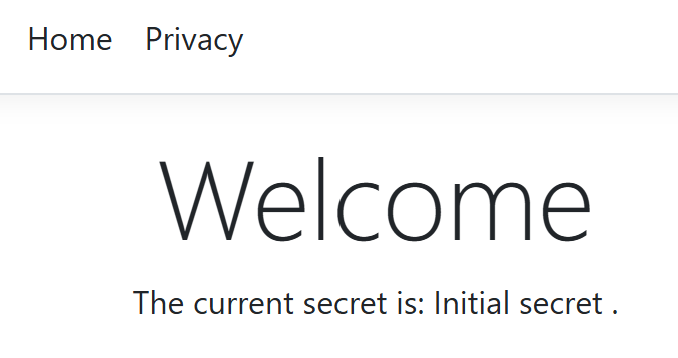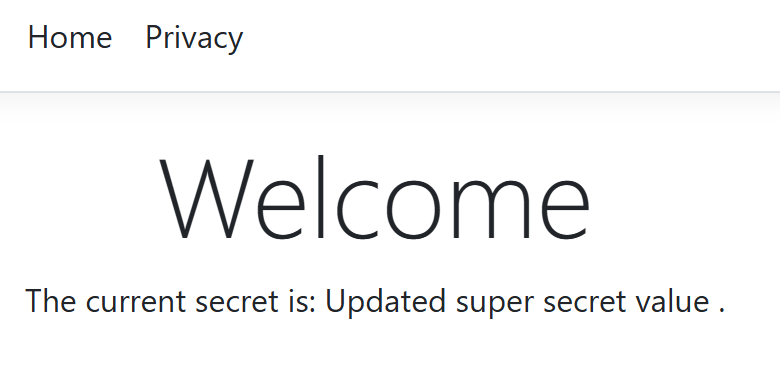A popular way to utilize secrets stored in Key Vault within an App Service is by utilizing a Key Vault reference in the configuration of the App Service. This allows you to create an app setting with a name of ExampleSecret and then specify a value that points to a secret stored in Key Vault @Microsoft.KeyVault(SecretUri=https://kv-kvreference.vault.azure.net/secrets/example-secret). In your web application you can then simply fetch the value of ExampleSecret and you have the actual secret from Key Vault. For more details and introduction on Key Vault references: Use Key Vault references as app settings in Azure App Service and Azure Functions
Initial configuration
In order for the App Service to fetch the secret from Key Vault it would need to have access. This is typically done by having a System Assigned Managed Identity on the App Service. You can then provide this identity access to read secrets from Key Vault. A personal preference is to use the Azure Role-Based Access Control option, an example would look something like this:
resource keyVault 'Microsoft.KeyVault/vaults@2023-02-01' = {
name: 'kv-${solutionName}'
location: location
properties: {
sku: {
family: 'A'
name: 'standard'
}
tenantId: subscription().tenantId
enableRbacAuthorization: true
enabledForDeployment: true
}
}
resource appServicePlan 'Microsoft.Web/serverfarms@2022-09-01' = {
name: 'asp-${solutionName}'
location: location
sku: {
name: 'F1'
tier: 'Free'
size: 'F1'
capacity: 1
}
}
resource webApp 'Microsoft.Web/sites@2022-09-01' = {
name: 'web-${solutionName}'
location: location
properties: {
serverFarmId: appServicePlan.id
httpsOnly: true
}
identity: {
type: 'SystemAssigned'
}
}
resource keyVaultSecretReadAccess 'Microsoft.Authorization/roleAssignments@2022-04-01' = {
name: guid(webApp.id, 'Key Vault Secrets Reader')
properties: {
roleDefinitionId: resourceId('Microsoft.Authorization/roleDefinitions', '4633458b-17de-408a-b874-0445c86b69e6') // Key Vault Secrets User
principalId: webApp.identity.principalId
}
}
Within the Key Vault you can then store a secret named example-secret. Within a .NET web application you could then refer to it using _configuration["ExampleSecret"] as the setting on the App Service is called ExampleSecret. This would make you web application look like this:

Updating the secret to a new value
Now it’s time to change the value of our secret, let’s update it to Updated super secret value. When you now refresh our web application you still see the initial value. That wasn’t really the plan…
You now have the option to wait till the secret gets updated somewhere within the 24-hour window. Alternatively you could make a call to https://management.azure.com/[Resource ID]/config/configreferences/appsettings/refresh?api-version=2022-03-01 to refresh the secrets. That already sounds a lot better! To make it easy you would typically call this using either Invoke-AzRestMethod in PowerShell or az rest in Azure CLI. This way you don’t have to deal with authentication yourself.
Invoke-AzRestMethod -Method:POST -Uri https://management.azure.com/subscriptions/[subscription id]/resourceGroups/rg-kv-reference/providers/Microsoft.Web/sites/web-kvreference/config/configreferences/appsettings/refresh?api-version=2022-03-01
az rest --method POST --url /subscriptions/[subscription id]/resourceGroups/rg-kv-reference/providers/Microsoft.Web/sites/web-kvreference/config/configreferences/appsettings/refresh?api-version=2022-03-01
After executing this you get back a response summarizing which secrets have been refreshed and if this was successful:
{
"id": null,
"nextLink": null,
"value": [
{
"id": "/subscriptions/[subscription id]/resourceGroups/rg-kv-reference/providers/Microsoft.Web/sites/web-kvreference/config/configreferences/appsettings/ExampleSecret",
"location": "Sweden Central",
"name": "ExampleSecret",
"properties": {
"activeVersion": null,
"details": "Reference has been successfully resolved.",
"identityType": "SystemAssigned",
"reference": "@Microsoft.KeyVault(SecretUri=https://kv-kvreference.vault.azure.net/secrets/example-secret)",
"secretName": "example-secret",
"status": "Resolved",
"vaultName": "kv-kvreference"
},
"type": "Microsoft.Web/sites/config/configreferences"
}
]
}
When you now refresh your web application you will get the updated value:

Conclusion
This way you can tell your App Service to refresh the secrets when you update them in Key Vault. This is beneficial for systems that use a single secret at a time. If you for example have a primary key and a secondary key you can safely wait for the 24-hour rollover period. Whenever that’s not the case you now have an Azure CLI and Azure PowerShell command to force the refresh, we could of course embed this inside of a GitHub Actions workflow or Azure Pipelines.